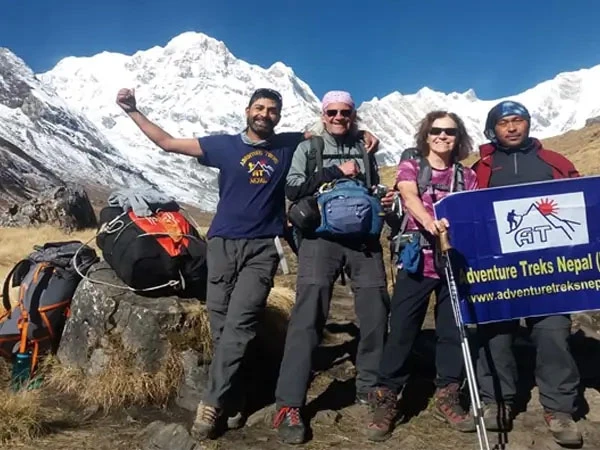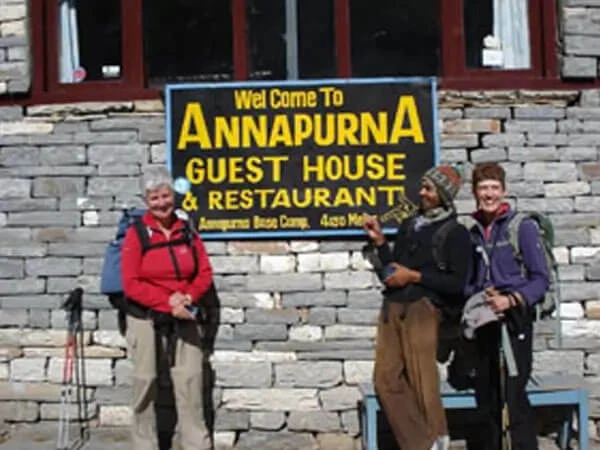Why is choosing the time to trek to Annapurna Base Camp crucial?
Choosing the right time to traverse diverse landscapes to reach Annapurna Base Camp (4130m) is essential to avoid possible challenges due to the unpredictable weather of the Himalayas. Even though autumn and spring are optimal periods of the year, you need proper preparation for making your dream trek successful with the best weather for ABC trek. Generally, monsoon (June to August) and winter (December to February) are considered off-seasons for trekking in Annapurna. The monsoon’s heavy rain leads to slick and muddy trails and landslides, making journeys more demanding due to difficult navigation. In a similar way, the winter brings heavy snowfalls, resulting in avalanches while walking through the varied landscapes of the Annapurna region that span from smooth plains to more rugged terrains. Mountain lovers can not savor the surreal beauty of the mountain giants during these off-seasons of trekking in Annapurna due to less visibility from fogs and heavy rainfalls. Therefore, selecting an optimal period of the year is key to the success of the journey to Annapurna Base Camp, making it a once-in-a-lifetime experience.
When is the best time for the Annapurna Base Camp Trek?
It's your preference to decide on the time of the year for the Annapurna Base Camp trek, depending on your desires and assumptions. Generally, autumn (September to November) and spring (March to May) are considered the best Annapurna trekking seasons for clear mountain views of Annapurna and the experience of trekking through forests filled with blooming rhododendrons of Annapurna. Due to several landslide-prone areas and difficult terrain with steep ascents and descents, monsoon (June to August) and winter (December to February) are off-seasons for trekking in Annapurna. Remember that every season has its advantages and limitations. Therefore, read our whole blog for extensive information that will help you choose an ideal period. We have given the breakdowns of the best trekking seasons in the Annapurna region as follows:
Why is the Spring (March to May) season the best time to trek to Annapurna Base Camp?
Like for every trekking destination in Nepal, spring is an optimal period of the year for trekking to Annapurna Base Camp due to its stable weather with moderate temperatures and longer daylight hours, making it easier for the prolonged walk of the ABC trek, which covers approximately 5 to 6 hours on average per day, in comparison to winter and monsoon. The atmosphere of the region becomes more stunning with red and white blooming rhododendrons, adding significance to the charm of clear 360 views of Annapurna Mountain and other peaks. The Annapurna Base Camp trail conditions are drier and smooth, allowing trekkers comfortable walk. Hence, the spring enchants adventurers since nature becomes alive again after winter. To make you more clear, we have provided the more information about the Spring, one of the best Annapurna trekking seasons in the following way:

Favorable weather: Why does optimal climate help you enhance your Annapurna Base Camp Trekking?
As mentioned earlier, spring creates an ideal atmosphere for trekkers, offering pleasant conditions for mobility with the proper equipment. It also highlights an iconic period of the year for varied wildlife, enabling them to flourish in their natural habitat, making your hike even more enjoyable through dense and lush forests teeming with diverse vegetation like rhododendrons, oaks, maples, etc. Since the trek goes through the Annapurna Conservation Area, you might have glimpses of rare animals like the Himalayan black bear, musk deer, snow leopard, Himalayan Tahr, langur monkey, wild boar, and red panda. Additionally, birdwatchers can capture the best pictures of birds such as the Danphe, vultures, golden eagles, peregrine falcons, white-rumped vultures, Eurasian nutcrackers, etc. Days are generally warm and sunny, while nights remain cool. Many trekkers prefer these trekking conditions to extreme freezing temperatures and dynamic weather during other seasons. The temperature in the daytime is warm due to sunlight, while nights remain cool, and sometimes conditions lead to extreme freezing temperatures.
What Makes the Spectacular Floral Displays of Spring in Annapurna Base Camp Unforgettable?
The Annapurna trails, adorned with blooming wildflowers such as rhododendrons and magnolias, will stir your heart while navigating them with their aromatic fragrance. These beautiful flowers will add an extra charm to the atmosphere of the Annapurna region, encompassed by majestic mountain giants. At every step of the trek, you will twist and find serenity amidst the glory of the Himalayas, heightening the experience in lively nature and scents of blossoms.

What Clear Mountain Views Await You On the way to Annapurna Base Camp?
Spring is not only a blooming paradise, as it offers mountain enthusiasts a golden opportunity to savor the charm of towering and snow-clad peaks, including clear mountain views of Annapurna (8091 m), Mt. Dhaulagiri, and Mt. Machhapuchhre, that stand high against crystal clear blue skies without any obstruction. Whether you are a novice or expert photographer, nature itself creates a beautiful environment for photography of the mountain giants and surrounding scenes. The sun’s brightness adds an extra layer of beauty to the Annapurna’s natural glamour, making it more captivating for capturing its allure on camera. You don' t have to tackle problems in Spring like monsoon challenges in Annapurna Base Camo Trek.
How Pleasant Weather Enhances the ABC Trek Experience?
The long days of hiking through diverse landmarks will be much more delightful due to the pleasant trekking temperatures of the Annapurna region in the spring. The temperature rises to 20 degrees during the daytime, making it suitable for travelers to navigate the trails in a warm atmosphere. But the temperature decreases to around 5 degrees or sometimes to minus degrees (below freezing) in early spring. Therefore, we advise you to pack essential equipment, including woolen clothes, to protect yourselves from the chilly winds and severe cold of the Himalayas.
Why Autumn is the Perfect Time to Embark on the Annapurna Base Camp Trek?
Autumn months, from September to November, are really for trekking enthusiasts to reach the base of Mt. Annapurna because of its pleasant weather, clear skies, more stunning vistas of the mountains, and festive vibes, enhancing the entire hiking experience. Trekkers love this post-monsoon period of the year for several reasons. As in the springtime, one can have pleasurable experiences walking on dry, easy paths while also immersing oneself in the vibrant cultural activities of small settlements of ethnic groups like Magar and Gurung. In this season, a variety of cultural events such as the festivals of Dashain, Tihar, and Chhath. However, autumn also brings a high volume of trekkers to the Annapurna region, making the trekking trails crowded and teahouses fill up quickly, which may require early planning and reservations. However, autumn has become the best time for the Annapurna Base Camp trek for several trekkers, offering a perfect mixture of natural beauty, rich cultural immersion, and stable weather conditions.
How will dry trails make your journey comfortable to Annapurna Base Camp (4130m)?
Trekkers do not have to face more trouble on the route to Annapurna Base Camp during Autumn since the risk of slips and falls is less. The dry and less muddy trails of the trek will make the paths easier to navigate, ensuring a safe, comfortable, and delightful journey, since the dry trails reduce the chance of getting your feet wet or dirty. One can traverse varied landscapes without worrying about landslides, avalanches, and floods because heavy rain and snowfall don't occur in this season as in monsoons and winter, respectively. Therefore, Annapurna Base Camp trail conditions in the autumn allow you to focus on magnificent scenery rather than strenuous hiking or walking experiences.

What kind of ideal weather and breathtaking mountain views should one expect when going on an Autumn trek to the Annapurna Base Camp?
The autumn season will provide a wonderful environment with crystal clear skies and mild temperatures, making it an ideal period for hiking through the Annapurna Conservation Area and the other sections of the Annapurna Base Camp Trek. On the way, you can have glimpses of unique wildlife and vegetation while savoring the charm of stunning mountains such as Mt. Annapurna, Dhaulagiri, Machhapuchhre, etc. At nighttime, you might feel cold due to chilly winds and lower temperatures, which sometimes decrease to freezing.
How Does Autumn Enhance Your Cultural Immersion Along the Annapurna Trails?
Depending on the ABC itinerary of Adventure Treks Nepal, you will get an extraordinary chance to indulge in the unique Himalayan cultures of different communities while traversing Nayapul, Ghorepani, Chule, Tadapani, and Chhomrong to reach Annapurna Base Camp and returning to Pokhara through picturesque villages like Bamboo, Sinua, and Jhinu Danda in any season. However, autumn offers the opportunity to participate in national festivals like Dashain, Tihar, and Chhath, enriching your cultural immersion and helping you build deeper connections with the local communities. Travelers are greeted by the locals according to the traditions of different groups, who provide some delicious local cuisine. The villages come alive with vibrant decorations, twinkling lights, traditional music, dances, and festive gatherings. During Dashain, you'll witness the cultural practice of elders applying tika to the foreheads of younger generations, accompanied by heartfelt blessings. During Tihar, you will enjoy it more due to the lights and witness paying tribute to animals like cows, dogs, and crows.
Is it possible to trek to Annapurna Base Camp in winter?
Winter showcases its characteristics for relishing the allure of the Annapurna Region, even though it’s more challenging in comparison to the autumn and spring seasons due to freezing temperatures at nighttime. Skies are clearer in the daytime and offer spectacular panoramas of mountain giants after fogs and clouds are blown by crisp air. The Annapurna trails become less busy, allowing trekkers to discover natural gems in broad spaces in the winter. Some trekking companies will give discounts on packages of different regions like the Annapurna, Everest, or Langtang regions due to the period of off-season. However, you can survive the winter months if you're prepared for the cold, particularly in low-altitude environments. In the winter, daily highs are between 9°C and 12°C, while overnight lows are below freezing.
Trekking around Annapurna during winter may present several obstacles because of snowfalls and avalanches, giving you a worse experience. Nevertheless, if you want to avoid crowds and enjoy isolation in the wilderness of Annapurna, we will help you in completing your dream journey. We have expert Nepal trekking guides and local trekkers who can help you navigate difficult parts of the trek to Annapurna Base Camp, including icy terrains and steep and narrow trails. Adventure Treks Nepal offers the best package for the ABC trek, including essential trekking equipment. If you're unsure whether to invest in gear for a single trip, we've got you covered. After concluding the trek, you can return to us. The trekking gear includes every essential for the winter season. For the winter season, we have packages like the Mardi Himal Trek, the Ghorepani Poonhill Trek, and the Annapurna Excursion, which will be less strenuous than the Annapurna Base Camp trek.
How does the monsoon season affect trail conditions and visibility on the ABC trek?
Generally, the monsoon season is considered an off-season for trekking in the Annapurna region due to the high likelihood of slick and muddy trails, which can make navigation challenging. Mountain lovers can not capture panoramic vistas of towering peaks due to weak visibility since the monsoon brings heavy rain almost everywhere in the Nation. However, you can witness green hills, lush forests, cascading waterfalls, and picturesque villages along the way without the disturbance of a huge population. We don’t recommend trekking to Annapurna Base Camp during this season since the paths of the trek also pass through some difficult sections, including landslide-prone areas.
Additionally, unforeseen events like flight delays and cancellations occur due to unfavorable weather conditions like rainfall, storms, etc. Therefore monsoon challenges in Annapurna Base Camp Trek presents obstacles on the way, making the journey more difficult. For travelers with vacations during the monsoon season who love exploring Nepal’s landmarks, the rain-shadowed regions of Upper Mustang and Dolpo offer stunning mountain vistas and breathtaking natural scenery. Even though the temperature is higher than in other seasons, adventurers get a great chance to have a blend of nature, culture, and adventure during monsoon seasons in such places. Some companies provide discounts on packages during this off-season, and you can enjoy rewards and challenges together without emptying your wallet.
How to prepare for the Annapurna Base Camp Trek?
Annapurna Base Camp trekking trails start from gorgeous valleys and then progress to the more rugged, narrow terrain, where steep ascents and descents take place. Therefore, you need to prepare for physical and mental challenges during this trip. We have mentioned below some essentials tips which will help you to prepare the journey to Annapurna Base Camp.
- Do research about the trail conditions, climates, and difficulty level of Annapurna Base Camp before venturing into this exhilarating journey.
- Obtain the right travel insurance that covers medical evacuations, including helicopter evacuation over 4000m in case of emergencies, and other unforeseen incidents such as flight delays, cancellations, personal belongings lost or stolen, etc.
- Involve yoursel in cardiovascular exercises such as hiking, climbing, jumping, running, swimming, cycling, etc. to stregthen your body for prolonged walking in varied landmarks of Annapurna.
- Take part in yoga practice or meditation for mental resilience, preparing yourself mentally.
- Select the best trekking company that ensures your safety and everything during the entire journey.
- Acquire mandatory permits for the Annapurna Base Camp Trek, such as the TIMS (Trekkers Information Management System) card and the Annapurna Conservation Area Permit (ACAP) through prestigious travel agencies like Adventure Treks Nepal which will be verified at check points during ABC trek.
- Make sure that your trekking guide has expertise in managing high acute sickness and other injuries and knowledge of local places, including local dialects and cultures to give you sufficient information.
- Climb gradually to the higher points without rushing to avoid acute altitude sickness.
- Stay hydrated and eat nutritious food to push yourself to accomplish the journey.
- Always listen to your body, and descend to the lower elevation when you feel some symptoms of high altitude sickness.

What to pack for the Annapurna Base Camp Trek?
The right gear for the Annapurna Base Camp Trek will assist in completing your journey safely in any season through diverse landscapes with several rewards and challenges. You should strategically pack to have the best experiences, making the journey once in a lifetime. Trekking enthusiasts often face the dilemma of packing lists, feeling they can never have enough gear, leading to overpacking and difficulty walking for prolonged periods. While trekking to Annapurna Base Camp, you can pack the following essentials:
Autumn Essentials
- Thermal base layers, fleece, and down for layering.
- Outer waterproof shell in case of rain.
- Comfortable hiking boots with gaiters for dusty trails.
- Warm hats, gloves, and buffs for the elevation.
- Sunglasses and sunscreen protect against higher UV rays.
- Sleeping bag for sub-zero temperatures.
Spring Essentials
- Underwear, moisture-wicking base layers.
- Insulated jackets for the cold mornings and evenings.
- Waterproof jackets and pants for spring showers.
- Good hiking boots with grip.
- Sun protection includes sunglasses, sunscreen, and a wide-brimmed hat.
Monsoon Essentials
- Quick-dry clothes (don't use cotton)
- Top-notch waterproof apparel like jackets, trousers, and backpack covers
- Trekking poles for slippery paths
- Waterproof hiking boots and spare socks
- Insect repellent + light rain cover
- Light layers for warmth at mid-lower altitudes.
Winter Essentials
- Heavyweight thermal base.
- Insulated down jacket and pants.
- The outer shell (highly waterproof and windproof)
- Winter-grade hiking boots (ice sections).
- Thick gloves, a balaclava, and a warm beanie.
- Extreme cold-rated sleeping bag (-15 and below).
- Hand warmers and a thermos for hot drinks.
Conclusion
Every season offers you a unique experience during Nepal trekking. If you embark on the Annapurna Base Camp Trek with suitable clothing, trekking gear, footwear, and other essentials, you can enjoy the surreal charm of nature and cultural heritage in any season. If you want to walk through trails that are adorned with blooming rhododendrons and other wildflowers, choose spring, and for more cultural immersion, choose autumn. If you want some discounts on packages and enjoy less-crowded trails, monsoon and winter are appropriate. But you should be ready to tackle the difficulties on trails to Annapurna Base Camp. If you want to join us for your next trip to Annapurna Base Camp after reading this latest blog, you can contact us for further inquiries. We have other best packages like Ghorepani Poon Hill Trek, Annapurna Circuit Trek, Annapurna Dhaulagiri Trek, Annapurna Excursion, Mardi Himal Trek, Annapurna Sanctuary Trek, and Dhampus Sarangkot Trek with Chitwan Jungle Safari for the Annapurna region. Hurry up! We are here at Adventure Treks Nepal to assist you in planning your next trip with the best packages at affordable costs, providing professional guides and local porters.











